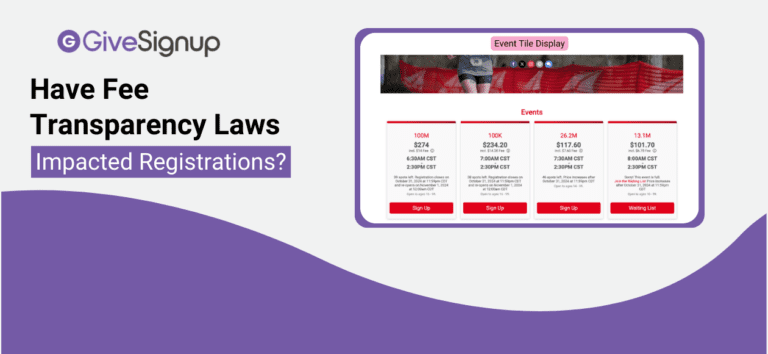Fee transparency laws have been enacted in several states, and a Federal Law is working it’s way through the system. While it’s early to draw any strong conclusions about the impact of the pricing changes on ticket sales, wanted to take a quick look at how events have fared in states that have passed fee transparency laws.
Race Growth is Similar Regardless of Fee Transparency
When reviewing the race growth on our platform in consecutive years, we saw similar growth between races in fee transparency states, and those without enforced all-in pricing. The 7 states with all-in pricing enforced grew an average of 7%, while the remaining states saw growth of 7.5%. No states with all-in pricing saw a per-race decline compared to last year. While the growth was slightly higher in states without fee transparency laws, the similar rate of growth suggests the laws haven’t made a real impact on sales.
To review the possible impact of fee transparency in pricing, we compared the per-race growth of races in states with required all-in pricing to growth in races that do not require transparent pricing. However, this comes with two important caveats.
- Limited data: State-specific data can be less reliable simply because there aren’t that many events in any given state. This means a big swing for one or two big events or a single poor-weather weekend can have a significant impact on registrations. While we shared the state-by-state breakdown, we recommend not drawing strong conclusions from a single state.
- Varied start dates: Different states enacted fee transparency laws at different points, so for some states we we could compare events from July through February, while some states could only look at December through January. This makes the comparison a bit messy.
| State | Dates Compared | # of Races Included | % Growth |
| California | 7/1-2/24 | 597 | 8.4% |
| Colorado | 8/7-2/24 | 257 | 7.2% |
| Connecticut | 10/15-2/24 | 102 | 2.2% |
| Maryland | 7/1-2/24 | 291 | 1.9% |
| Minnesota | 1/1-2/24 | 20 | 13.8% |
| New York | 7/1-2/24 | 660 | 9.0% |
| Tennessee | 10/15-2/24 | 125 | 6.4% |
| All Other States | 7/1-2/24 | 10,085 | 7.5% |
The Impact of Display Options for All-In-Pricing
There are two ways that races have chosen to display all-in-pricing:
1. Passing on the Processing Fee: For races that pass the processing fee onto their participants, the race price shows with base fee + the highest possible processing fee (and a note that all fees are included). This has the benefit of ensuring all fees are covered by participants (94% of races in 2024 passed fees onto participants), but does mean that the displayed price won’t be the even number you set (and the fee shown may be slightly higher than the actual fee in some circumstances).

2. Absorb the Processing Fee: Races who want to ensure a clean fee (I.E. $50) can set their base fee slightly higher and absorb the processing fees. When a race does this, the base price is the all-in pricing. This means there’s a little more variability in the per-person revenue (because processing fees are by-cart, not by person), but provides the race more control over the display of their pricing. If opting for this option, we recommend calling out that the price includes all fees.

We do see more races opting to absorb the processing fee in states with all-in-pricing. Nationally, just 6.3% of races opt to absorb fees, while in California, 21% of races have opted to absorb the processing fee since their fee transparency law was enacted.
Races that opted to absorb the price grew 9%, whereas races that passed on the fee grew 8.1%. Again, given the small sample size, we wouldn’t recommend drawing significant conclusions about which pricing display is better (especially given how similar the growth rate is), but it’s something we’ll keep an eye on.
Pricing Has Not Limited Race Growth
The final note in this conversation is that nationally, races grew in 2024 (an average of 8%) even as prices rose for all distances. This suggests that small price changes (such as the difference in seeing the processing fee upfront) is unlikely to deter participants from registering for your race.
